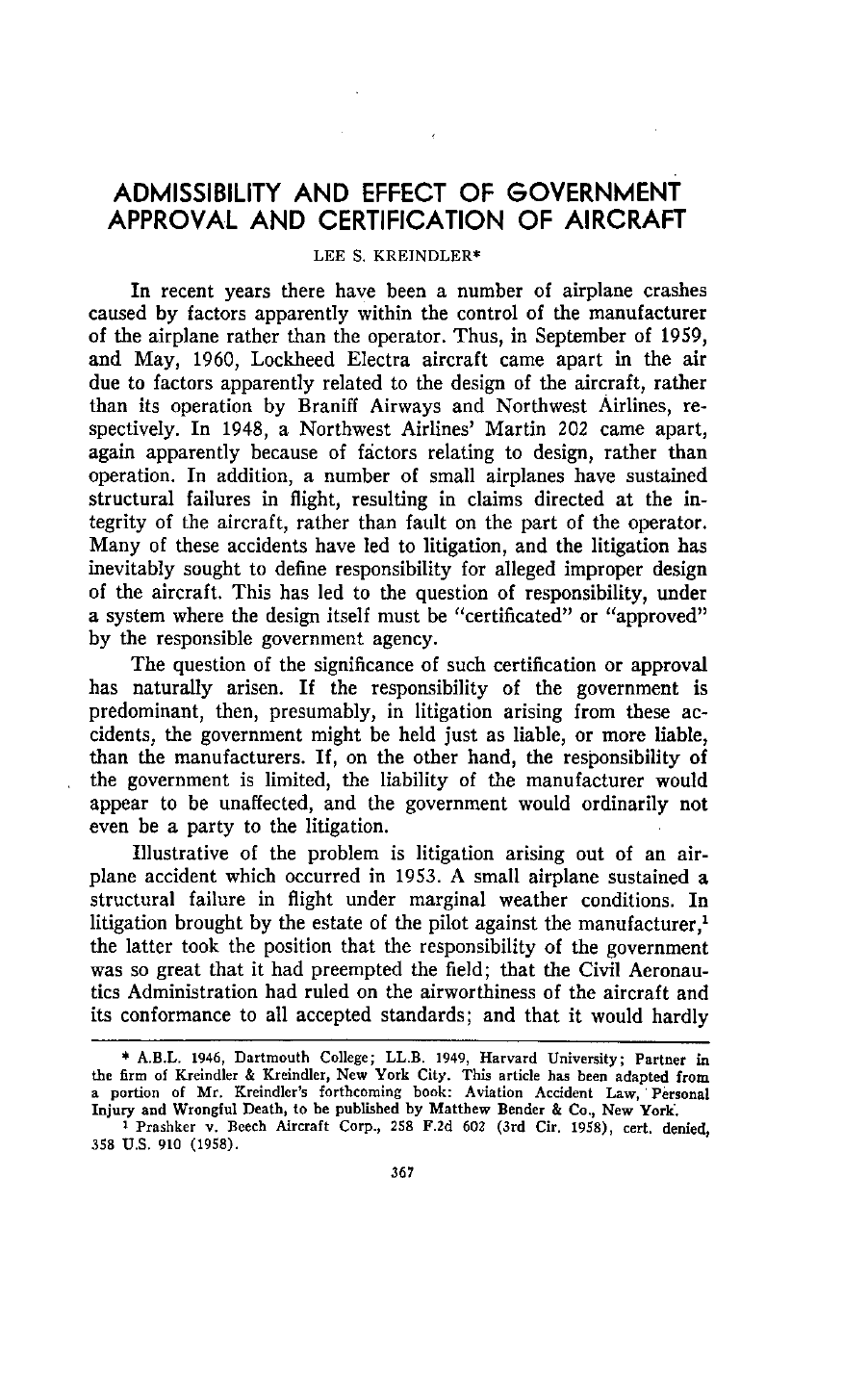
ADMISSIBILITY AND EFFECT OF GOVERNMENT
APPROVAL AND CERTIFICATION OF AIRCRAFT
LEE S KREINDLER*
In recent years there have been a number of airplane crashes
caused by factors apparently within the control of the manufacturer
of the airplane rather than the operator. Thus, in September of 1959,
and May, 1960, Lockheed Electra aircraft came apart in the air
due to factors apparently related to the design of the aircraft, rather
than its operation by Braniff Airways and Northwest Airlines, re-
spectively. In 1948, a Northwest Airlines' Martin 202 came apart,
again apparently because of factors relating to design, rather than
operation. In addition, a number of small airplanes have sustained
structural failures in flight, resulting in claims directed at the in-
tegrity of the aircraft, rather than fault on the part of the operator.
Many of these accidents have led to litigation, and the litigation has
inevitably sought to define responsibility for alleged improper design
of the aircraft. This has led to the question of responsibility, under
a system where the design itself must be "certificated" or "approved"
by the responsible government agency.
The question of the significance of such certification or approval
has naturally arisen. If the responsibility of the government is
predominant, then, presumably, in litigation arising from these ac-
cidents, the government might be held just as liable, or more liable,
than the manufacturers. If, on the other hand, the responsibility of
the government is limited, the liability of the manufacturer would
appear to be unaffected, and the government would ordinarily not
even be a party to the litigation.
Illustrative of the problem is litigation arising out of an air-
plane accident which occurred in 1953. A small airplane sustained a
structural failure in flight under marginal weather conditions. In
litigation brought by the estate of the pilot against the manufacturer,'
the latter took the position that the responsibility of the government
was so great that it had preempted the field; that the Civil Aeronau-
tics Administration had ruled on the airworthiness of the aircraft and
its conformance to all accepted standards; and that it would hardly
* A.B.L. 1946, Dartmouth College LLB 1949, Harvard University; Partner in
the firm of Kreindler & Kreindler, New York City. This article has been adapted from
a portion of Mr. Kreindler's forthcoming book: Aviation Accident Law, Personal
Injury and Wrongful Death, to be published by Matthew Bender & Co., New York.
1
Prashker v. Beech Aircraft Corp., 258 F.2d 602 (3rd Cir. 1958), cert. denied,
358 U.S. 910 (1958).
367
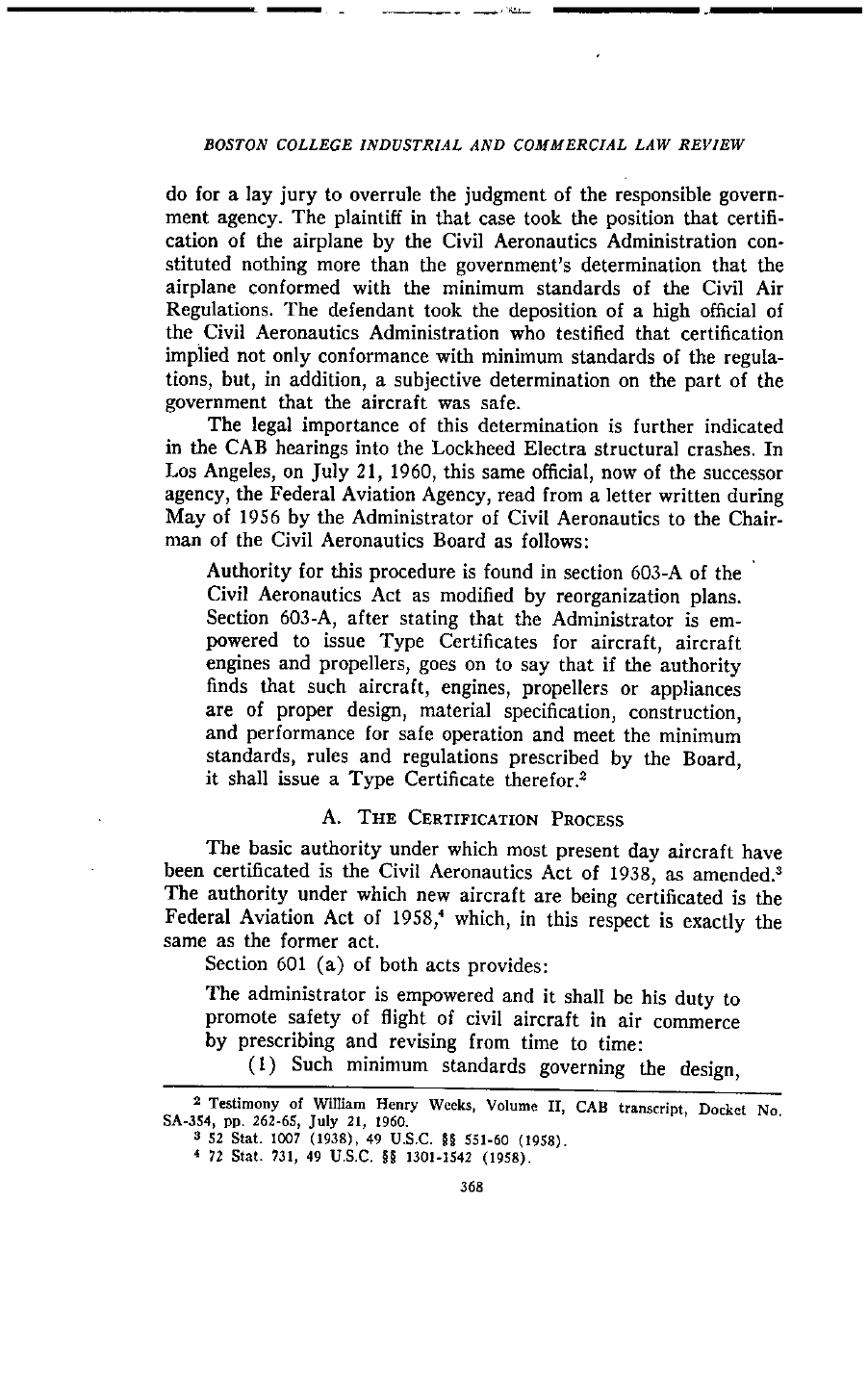
BOSTON COLLEGE INDUSTRIAL AND COMMERCIAL LAW REVIEW
do for a lay jury to overrule the judgment of the responsible govern-
ment agency. The plaintiff in that case took the position that certifi-
cation of the airplane by the Civil Aeronautics Administration con-
stituted nothing more than the government's determination that the
airplane conformed with the minimum standards of the Civil Air
Regulations. The defendant took the deposition of a high official of
the Civil Aeronautics Administration who testified that certification
implied not only conformance with minimum standards of the regula-
tions, but, in addition, a subjective determination on the part of the
government that the aircraft was safe.
The legal importance of this determination is further indicated
in the CAB hearings into the Lockheed Electra structural crashes. In
Los Angeles, on July 21, 1960, this same official, now of the successor
agency, the Federal Aviation Agency, read from a letter written during
May of 1956 by the Administrator of Civil Aeronautics to the Chair-
man of the Civil Aeronautics Board as follows:
Authority for this procedure is found in section 603-A of the
Civil Aeronautics Act as modified by reorganization plans.
Section 603-A, after stating that the Administrator is em-
powered to issue Type Certificates for aircraft, aircraft
engines and propellers, goes on to say that if the authority
finds that such aircraft, engines, propellers or appliances
are of proper design, material specification, construction,
and performance for safe operation and meet the minimum
standards, rules and regulations prescribed by the Board,
it shall issue a Type Certificate therefor.
2
A. THE CERTIFICATION PROCESS
The basic authority under which most present day aircraft have
been certificated is the Civil Aeronautics Act of 1938, as amended.
3
The authority under which new aircraft are being certificated is the
Federal Aviation Act of 1958,
4
which, in this respect is exactly the
same as the former act.
Section 601 (a) of both acts provides:
The administrator is empowered and it shall be his duty to
promote safety of flight of civil aircraft in air commerce
by prescribing and revising from time to time:
(1) Such minimum standards governing the design,
2
Testimony of William Henry Weeks, Volume II,
CAB
transcript, Docket No.
SA-354, pp. 262-65,
July
21, 1960.
3
52
Stat.
1007 (1938), 49 U.S.C.
551-60 (1958).
4
72
Stat.
731, 49
U.S.C. §§
1301-1542 (1958).
368
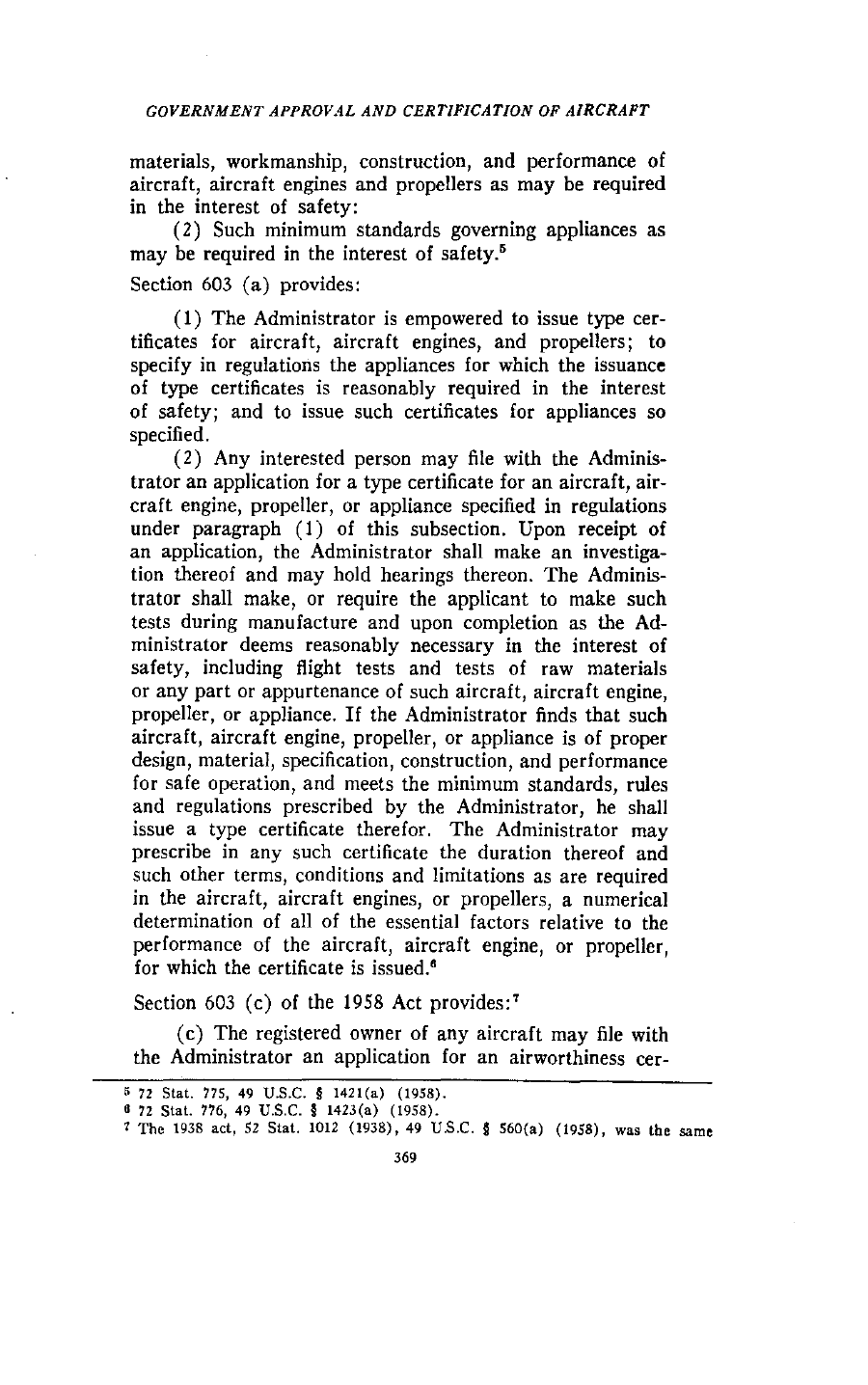
GOVERNMENT APPROVAL AND CERTIFICATION OF AIRCRAFT
materials, workmanship, construction, and performance of
aircraft, aircraft engines and propellers as may be required
in the interest of safety:
(2) Such minimum standards governing appliances as
may be required in the interest of safety.°
Section 603 (a) provides:
(1)
The Administrator is empowered to issue type cer-
tificates for aircraft, aircraft engines, and propellers; to
specify in regulations the appliances for which the issuance
of type certificates is reasonably required in the interest
of safety; and to issue such certificates for appliances so
specified.
(2)
Any interested person may file with the Adminis-
trator an application for a type certificate for an aircraft, air-
craft engine, propeller, or appliance specified in regulations
under paragraph (1) of this subsection. Upon receipt of
an application, the Administrator shall make an investiga-
tion thereof and may hold hearings thereon. The Adminis-
trator shall make, or require the applicant to make such
tests during manufacture and upon completion as the Ad-
ministrator deems reasonably necessary in the interest of
safety, including flight tests and tests of raw materials
or any part or appurtenance of such aircraft, aircraft engine,
propeller, or appliance. If the Administrator finds that such
aircraft, aircraft engine, propeller, or appliance is of proper
design, material, specification, construction, and performance
for safe operation, and meets the minimum standards, rules
and regulations prescribed by the Administrator, he shall
issue a type certificate therefor. The Administrator may
prescribe in any such certificate the duration thereof and
such other terms, conditions and limitations as are required
in the aircraft, aircraft engines, or propellers, a numerical
determination of all of the essential factors relative to the
performance of the aircraft, aircraft engine, or propeller,
for which the certificate is issued.°
Section 603 (c) of the 1958 Act provides:
7
(c) The registered owner of any aircraft may file with
the Administrator an application for an airworthiness cer-
5
72 Stat. 775, 49 U.S.C. § 1421(a) (1958).
6
72 Stat. 776, 49 U.S.C. § 1423(a) (1958).
7
The 1938 act, 52 Stat. 1012 (1938), 49 US.C. § 560(a) (1958), was
the same
369
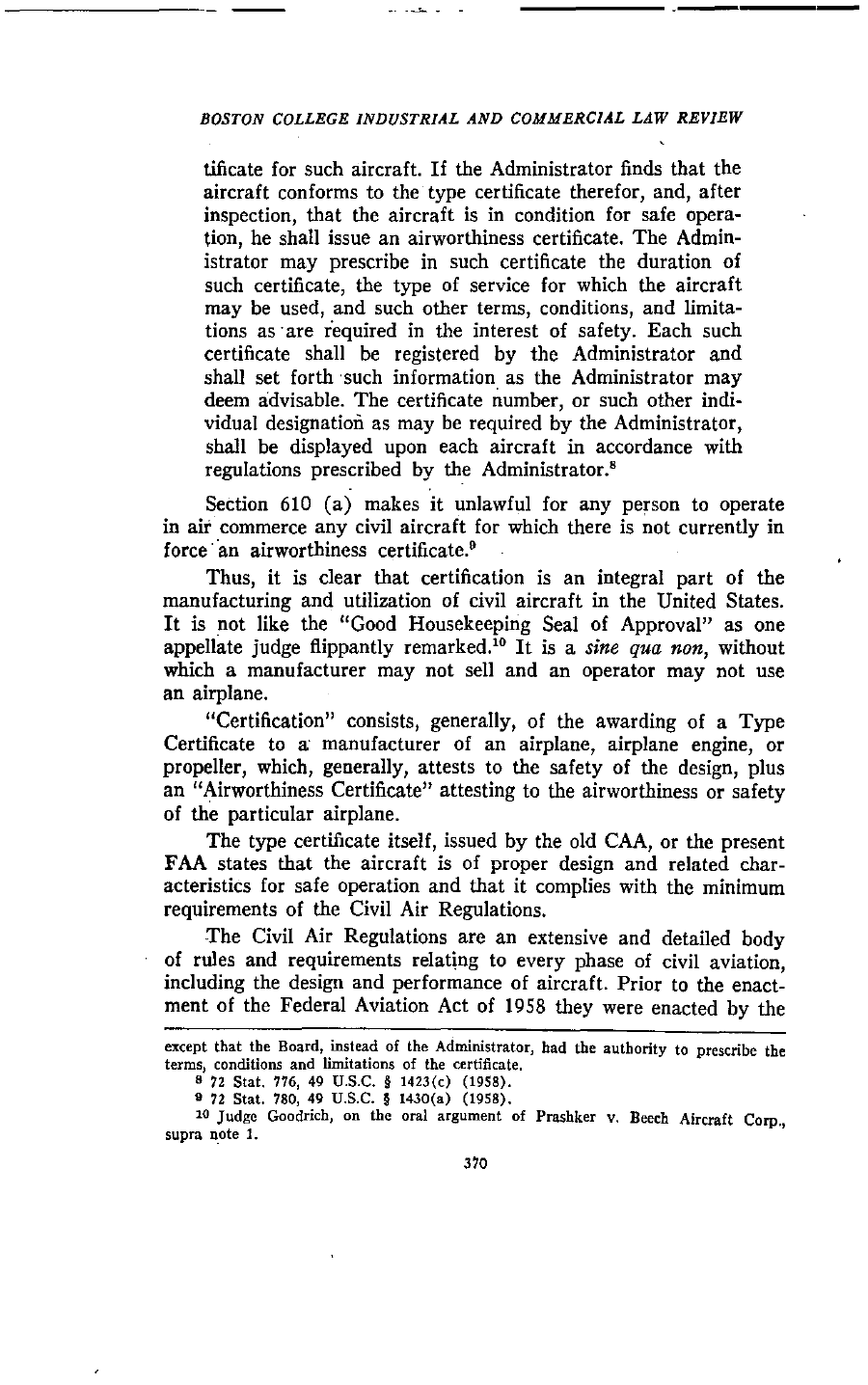
BOSTON COLLEGE INDUSTRIAL AND COMMERCIAL LAW REVIEW
tificate for such aircraft. If the Administrator finds that the
aircraft conforms to the type certificate therefor, and, after
inspection, that the aircraft is in condition for safe opera-
tion, he shall issue an airworthiness certificate. The Admin-
istrator may prescribe in such certificate the duration of
such certificate, the type of service for which the aircraft
may be used, and such other terms, conditions, and limita-
tions as are required in the interest of safety. Each such
certificate shall be registered by the Administrator and
shall set forth such information as the Administrator may
deem advisable. The certificate number, or such other indi-
vidual designation as may be required
by
the Administrator,
shall be displayed upon each aircraft in accordance with
regulations prescribed
by
the Administrator.
8
Section 610 (a) makes it unlawful for any person to operate
in air commerce any civil aircraft for which there is not currently in
force • an airworthiness certificate,
Thus, it is clear that certification is an integral part of the
manufacturing and utilization of civil aircraft in the United States.
It is not like the "Good Housekeeping Seal of Approval" as one
appellate judge flippantly remarked.' It is a
sine qua non,
without
which a manufacturer may not sell and an operator may not use
an airplane.
"Certification" consists, generally, of the awarding of a Type
Certificate to a manufacturer of an airplane, airplane engine, or
propeller, which, generally, attests to the safety of the design, plus
an "Airworthiness Certificate" attesting to the airworthiness or safety
of the particular airplane.
The type certificate itself, issued by the old CAA, or the present
FAA states that the aircraft is of proper design and related char-
acteristics for safe operation and that it complies with the minimum
requirements of the Civil Air Regulations.
The Civil Air Regulations are an extensive and detailed body
of rules and requirements relating to every phase of civil aviation,
including the design and performance of aircraft. Prior to the enact-
ment of the Federal Aviation Act of 1958 they were enacted by the
except that the Board, instead of the Administrator, had the authority to prescribe the
terms, conditions and limitations of the certificate.
8
72 Stat. 776, 49 U.S.C. § 1423(c) (1958).
9
72
Stat. 780, 49 U.S.C. § 1430(a) (1958).
19
Judge Goodrich, on the oral
argument
of Prashker v. Beech Aircraft Corp.,
supra note 1.
370
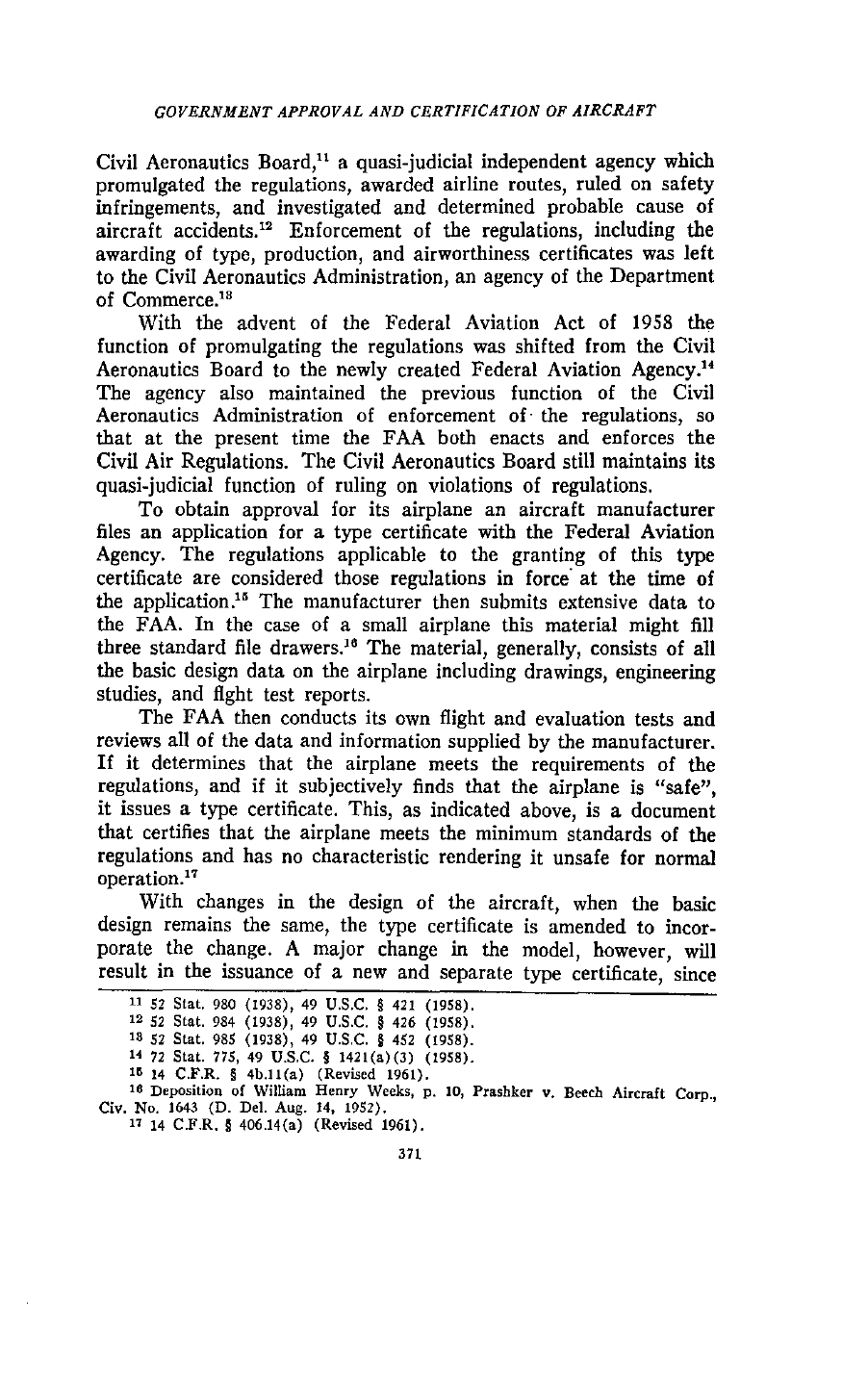
GOVERNMENT APPROVAL AND CERTIFICATION OF AIRCRAFT
Civil Aeronautics Board," a quasi-judicial independent agency which
promulgated the regulations, awarded airline routes, ruled on safety
infringements, and investigated and determined probable cause of
aircraft accidents." Enforcement of the regulations, including the
awarding of type, production, and airworthiness certificates was left
to the Civil Aeronautics Administration, an agency of the Department
of Commerce."
With the advent of the Federal Aviation Act of 1958 the
function of promulgating the regulations was shifted from the Civil
Aeronautics Board to the newly created Federal Aviation Agency."
The agency also maintained the previous function of the Civil
Aeronautics Administration of enforcement of • the regulations, so
that at the present time the FAA both enacts and enforces the
Civil Air Regulations. The Civil Aeronautics Board still maintains its
quasi-judicial function of ruling on violations of regulations.
To obtain approval for its airplane an aircraft manufacturer
files an application for a type certificate with the Federal Aviation
Agency. The regulations applicable to the granting of this type
certificate are considered those regulations in force at the time of
the application." The manufacturer then submits extensive data to
the FAA. In the case of a small airplane this material might fill
three standard file drawers." The material, generally, consists of all
the basic design data on the airplane including drawings, engineering
studies, and fight test reports.
The FAA then conducts its own flight and evaluation tests and
reviews all of the data and information supplied by the manufacturer.
If it determines that the airplane meets the requirements of the
regulations, and if it subjectively finds that the airplane is "safe",
it issues a type certificate. This, as indicated above, is a document
that certifies that the airplane meets the minimum standards of the
regulations and has no characteristic rendering it unsafe for normal
operation."
With changes in the design of the aircraft, when the basic
design remains the same, the type certificate is amended to incor-
porate the change. A major change in the model, however, will
result in the issuance of a new and separate type certificate, since
11
52 Stat. 980 (1938), 49 U.S.C. § 421 (1958).
12
52 Stat. 984 (1938), 49 U.S.C. § 426 (1958).
13
52 Stat. 985 (1938), 49 U.S.C. § 452 (1958).
14
72 Stat. 775, 49 U.S.C. § 1421(a)(3) (1958).
15
14 C.F.R. § 41).11(a) (Revised 1961).
to Deposition of William Henry Weeks, p. 10, Prashker v. Beech Aircraft Corp.,
Civ. No. 1643 (D. Del. Aug. 14, 1952).
17
14 CF.R. § 406.14(a) (Revised 1961).
371
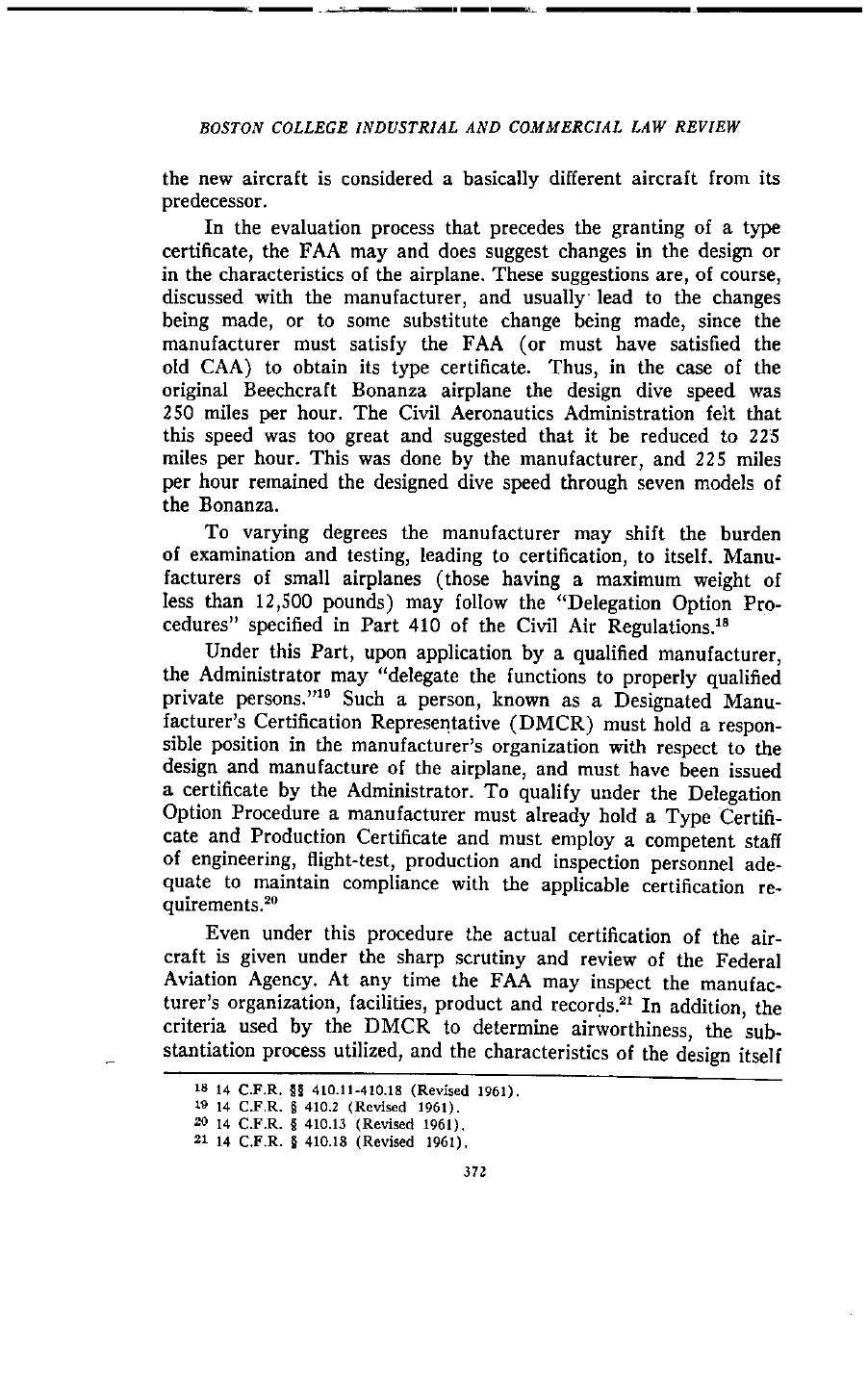
BOSTON COLLEGE INDUSTRIAL AND COMMERCIAL LAW REVIEW
the new aircraft is considered a basically different aircraft from its
predecessor.
In the evaluation process that precedes the granting of a type
certificate, the FAA may and does suggest changes in the design or
in the characteristics of the airplane. These suggestions are, of course,
discussed with the manufacturer, and usually lead to the changes
being made, or to some substitute change being made, since the
manufacturer must satisfy the FAA (or must have satisfied the
old CAA) to obtain its type certificate. Thus, in the case of the
original Beechcraft Bonanza airplane the design dive speed was
250 miles per hour. The Civil Aeronautics Administration felt that
this speed was too great and suggested that it be reduced to 225
miles per hour. This was done by the manufacturer, and 225 miles
per hour remained the designed dive speed through seven models of
the Bonanza.
To varying degrees the manufacturer may shift the burden
of examination and testing, leading to certification, to itself. Manu-
facturers of small airplanes (those having a maximum weight of
less than 12,500 pounds) may follow the "Delegation Option Pro-
cedures" specified in Part 410 of the Civil Air Regulations.m
Under this Part, upon application by a qualified manufacturer,
the Administrator may "delegate the functions to properly qualified
private persons."' Such a person, known as a Designated Manu-
facturer's Certification Representative (DMCR) must hold a respon-
sible position in the manufacturer's organization with respect to the
design and manufacture of the airplane, and must have been issued
a certificate by the Administrator. To qualify under the Delegation
Option Procedure a manufacturer must already hold a Type Certifi-
cate and Production Certificate and must employ a competent staff
of engineering, flight-test, production and inspection personnel ade-
quate to maintain compliance with the applicable certification re-
quirements.'
Even under this procedure the actual certification of the air-
craft is given under the sharp scrutiny and review of the Federal
Aviation Agency. At any time the FAA may inspect the manufac-
turer's organization, facilities, product and records.' In addition, the
criteria used by the DMCR to determine airworthiness, the sub-
stantiation process utilized, and the characteristics of the design itself
18
14 C.F.R. II 410.11-410.18 (Revised 1961).
19
14 C.F.R. I 410.2 (Revised 1961).
20
14 C.F.R.
410.13 (Revised 1961).
21
14 C.F.R. 1410.18 (Revised 1961).
372
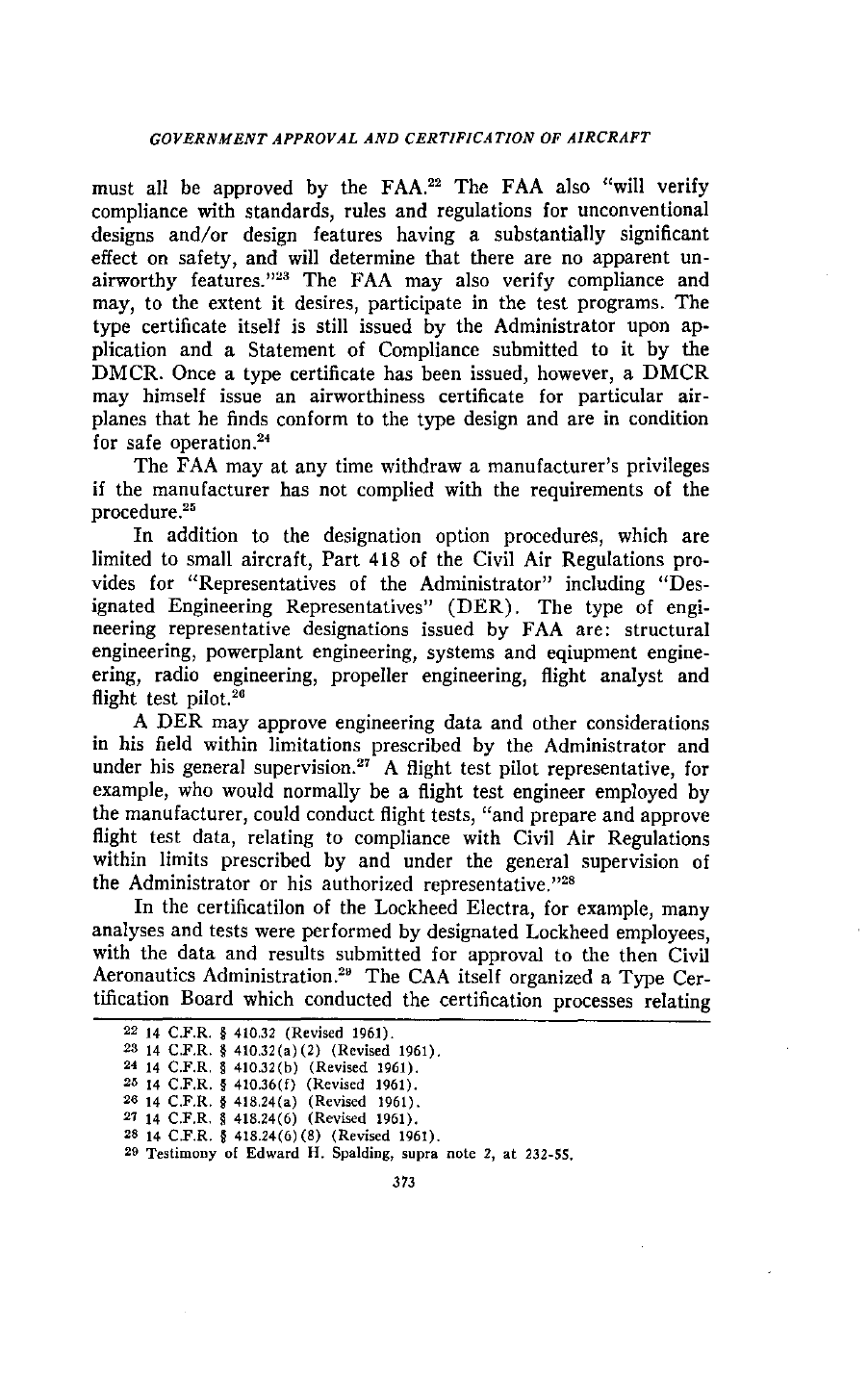
GOVERNMENT APPROVAL AND CERTIFICATION OF AIRCRAFT
must all be approved by the FAA.
22
The FAA also "will verify
compliance with standards, rules and regulations for unconventional
designs and/or design features having a substantially significant
effect on safety, and will determine that there are no apparent un-
airworthy features."
23
The FAA may also verify compliance and
may, to the extent it desires, participate in the test programs. The
type certificate itself is still issued by the Administrator upon ap-
plication and a Statement of Compliance submitted to it by the
DMCR. Once a type certificate has been issued, however, a DMCR
may himself issue an airworthiness certificate for particular air-
planes that he finds conform to the type design and are in condition
for safe operation."
The FAA may at any time withdraw a manufacturer's privileges
if the manufacturer has not complied with the requirements of the
procedure."
In addition to the designation option procedures, which are
limited to small aircraft, Part 418 of the Civil Air Regulations pro-
vides for "Representatives of the Administrator" including "Des-
ignated Engineering Representatives" (DER). The type of engi-
neering representative designations issued by FAA are: structural
engineering, powerplant engineering, systems and eqiupment engine-
ering, radio engineering, propeller engineering, flight analyst and
flight test pilot.'
A DER may approve engineering data and other considerations
in his field within limitations prescribed by the Administrator and
under his general supervision." A flight test pilot representative, for
example, who would normally be a flight test engineer employed by
the manufacturer, could conduct flight tests, "and prepare and approve
flight test data, relating to compliance with Civil Air Regulations
within limits prescribed by and under the general supervision of
the Administrator or his authorized representative.""
In the certificatilon of the Lockheed Electra, for example, many
analyses and tests were performed by designated Lockheed employees,
with the data and results submitted for approval to the then Civil
Aeronautics Administration." The CAA itself organized a Type Cer-
tification Board which conducted the certification processes relating
22
14 C.F.R. § 410.32 (Revised 1961).
23
14 C.F.R. § 410.32(a)(2) (Revised
1961).
24
14 C.F.R. § 410.32(6) (Revised 1961).
28
14 C.F.R. § 410.36(f) (Revised 1961).
26 14
C.F.R. §
418.24(a)
(Revised 1961).
27
14 C.F.R. § 418.24(6) (Revised 1961).
28
14 C.F.R. § 418.24(6)(8) (Revised 1961).
22
Testimony of Edward H. Spalding, supra note 2, at 232-55.
373
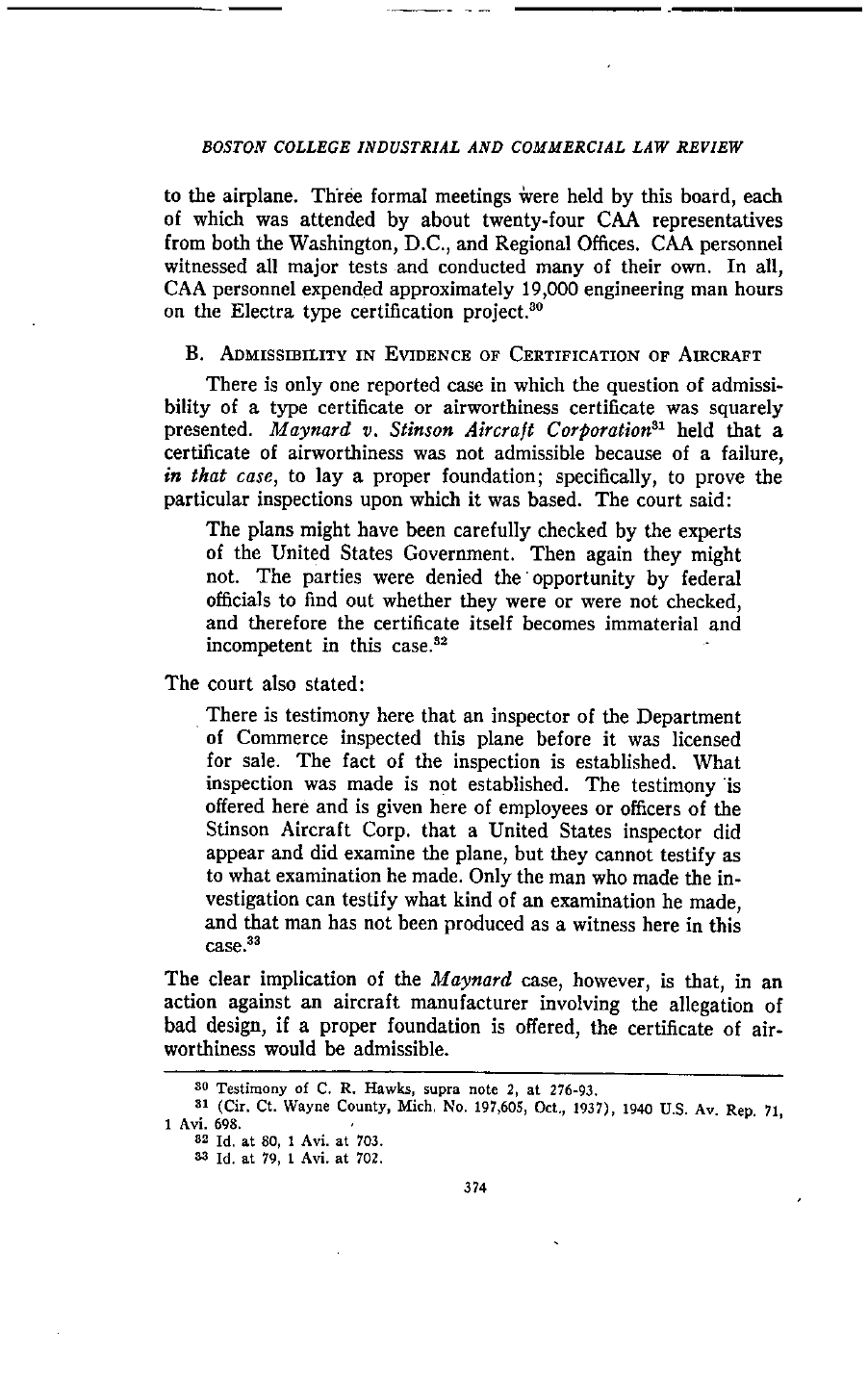
BOSTON COLLEGE INDUSTRIAL AND COMMERCIAL LAW REVIEW
to the airplane. Three formal meetings Were held by this board, each
of which was attended by about twenty-four CM representatives
from both the Washington, D.C., and Regional Offices. CM personnel
witnessed all major tests and conducted many of their own. In all,
CAA personnel
expended
approximately 19,000 engineering man hours
on the Electra type certification project."
B. ADMISSIBILITY IN EVIDENCE OF CERTIFICATION OF AIRCRAFT
There is only one reported case in which the question of admissi-
bility of a type certificate or airworthiness certificate was squarely
presented.
Maynard v. Stinson Aircraft Corporations'
held that a
certificate of airworthiness was not admissible because of a failure,
in that case,
to lay a proper foundation; specifically, to prove the
particular inspections upon which it was based. The court said:
The plans might have been carefully checked by the experts
of the United States Government. Then again they might
not. The parties were denied the opportunity by federal
officials to find out whether they were or were not checked,
and therefore the certificate itself becomes immaterial and
incompetent in this case."
The court also stated:
There is testimony here that an inspector of the Department
of Commerce inspected this plane before it was licensed
for sale. The fact of the inspection is established. What
inspection was made is not established. The testimony is
offered here and is given here of employees or officers of the
Stinson Aircraft Corp. that a United States inspector did
appear and did examine the plane, but they cannot testify as
to what examination he made. Only the man who made the in-
vestigation can testify what kind of an examination he made,
and that man has not been produced as a witness here in this
case.
33
The clear implication of the
Maynard
case, however, is that, in an
action against an aircraft manufacturer involving the allegation of
bad design, if a proper foundation is offered, the certificate of air-
worthiness would be admissible.
80
Testimony of C It. Hawks, supra note 2, at 276-93.
31
(Cir. Ct. Wayne County, Mich. No. 197,605, Oct., 1937), 1940 U.S. Av. Rep. 71,
1 Avi. 698.
32
Id. at 80, 1 Avi. at 703.
33
Id. at 79, 1 Avi. at 702.
374
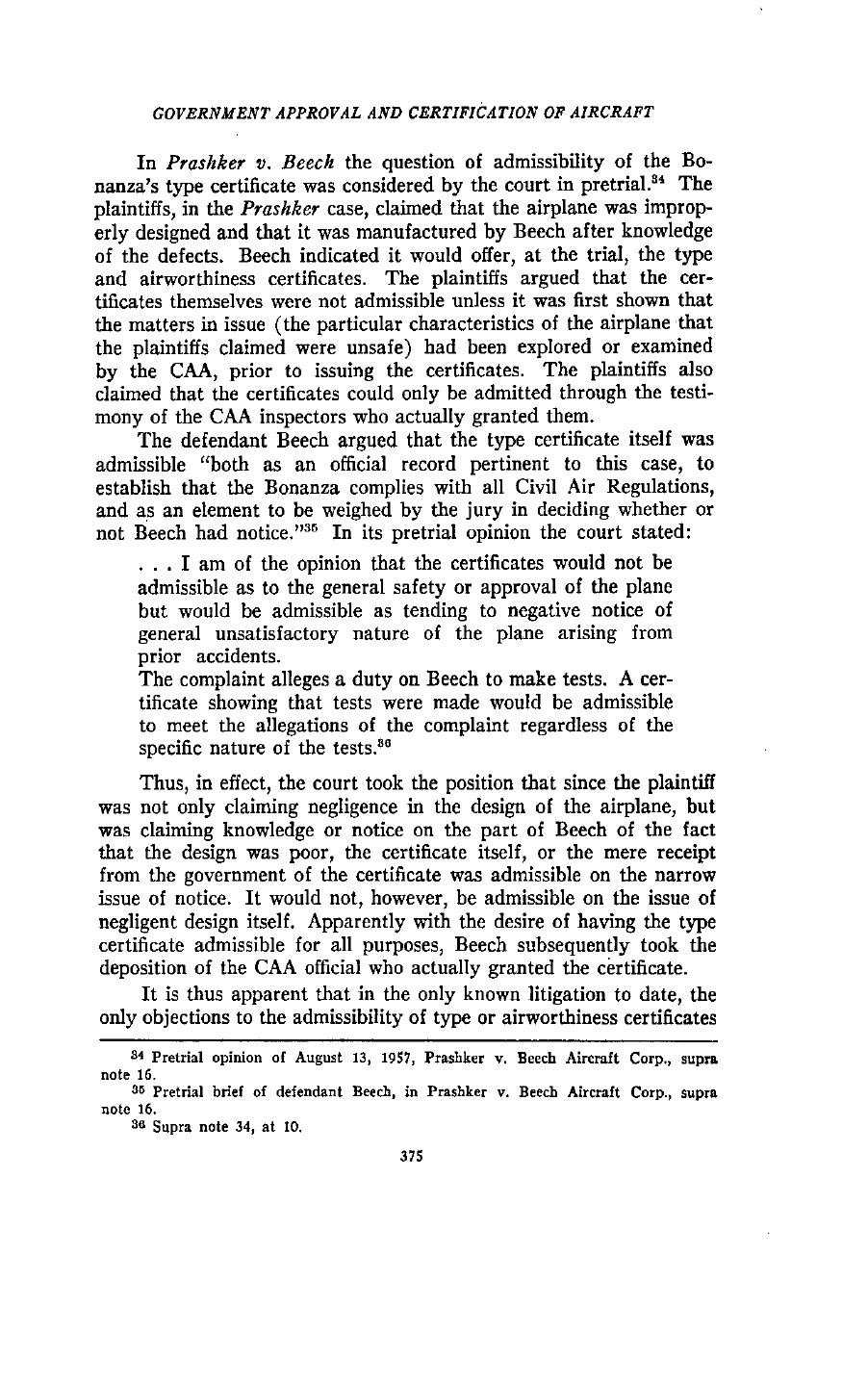
GOVERNMENT APPROVAL AND CERTIFICATION OF AIRCRAFT
In
Prashker v. Beech
the question of admissibility of the Bo-
nanza's type certificate was considered by the court in pretrial." The
plaintiffs, in the
Prashker
case, claimed that the airplane was improp-
erly designed and that it was manufactured by Beech after knowledge
of the defects. Beech indicated it would offer, at the trial, the type
and airworthiness certificates. The plaintiffs argued that the cer-
tificates themselves were not admissible unless it was first shown that
the matters in issue (the particular characteristics of the airplane that
the plaintiffs claimed were unsafe) had been explored or examined
by the CAA, prior to issuing the certificates. The plaintiffs also
claimed that the certificates could only be admitted through the testi-
mony of the CAA inspectors who actually granted them.
The defendant Beech argued that the type certificate itself was
admissible "both as an official record pertinent to this case, to
establish that the Bonanza complies with all Civil Air Regulations,
and as an element to be weighed by the jury in deciding whether or
not Beech had notice!"
36
In its pretrial opinion the court stated:
. . . I am of the opinion that the certificates would not be
admissible as to the general safety or approval of the plane
but would be admissible as tending to negative notice of
general unsatisfactory nature of the plane arising from
prior accidents.
The complaint alleges a duty on Beech to make tests. A cer-
tificate showing that tests were made would be admissible
to meet the allegations of the complaint regardless of the
specific nature of the tests."
Thus, in effect, the court took the position that since the plaintiff
was not only claiming negligence in the design of the airplane, but
was claiming knowledge or notice on the part of Beech of the fact
that the design was poor, the certificate itself, or the mere receipt
from the government of the certificate was admissible on the narrow
issue of notice. It would not, however, be admissible on the issue of
negligent design itself. Apparently with the desire of having the type
certificate admissible for all purposes, Beech subsequently took the
deposition of the CAA official who actually granted the certificate.
It is thus apparent that in the only known litigation to date, the
only objections to the admissibility of type or airworthiness certificates
34
Pretrial opinion of August 13, 1957, Prashker v. Beech Aircraft Corp., supra
note 16.
36
Pretrial brief of defendant Beech, in Prashker v. Beech Aircraft Corp., supra
note 16.
36
Supra note 34, at 10.
375
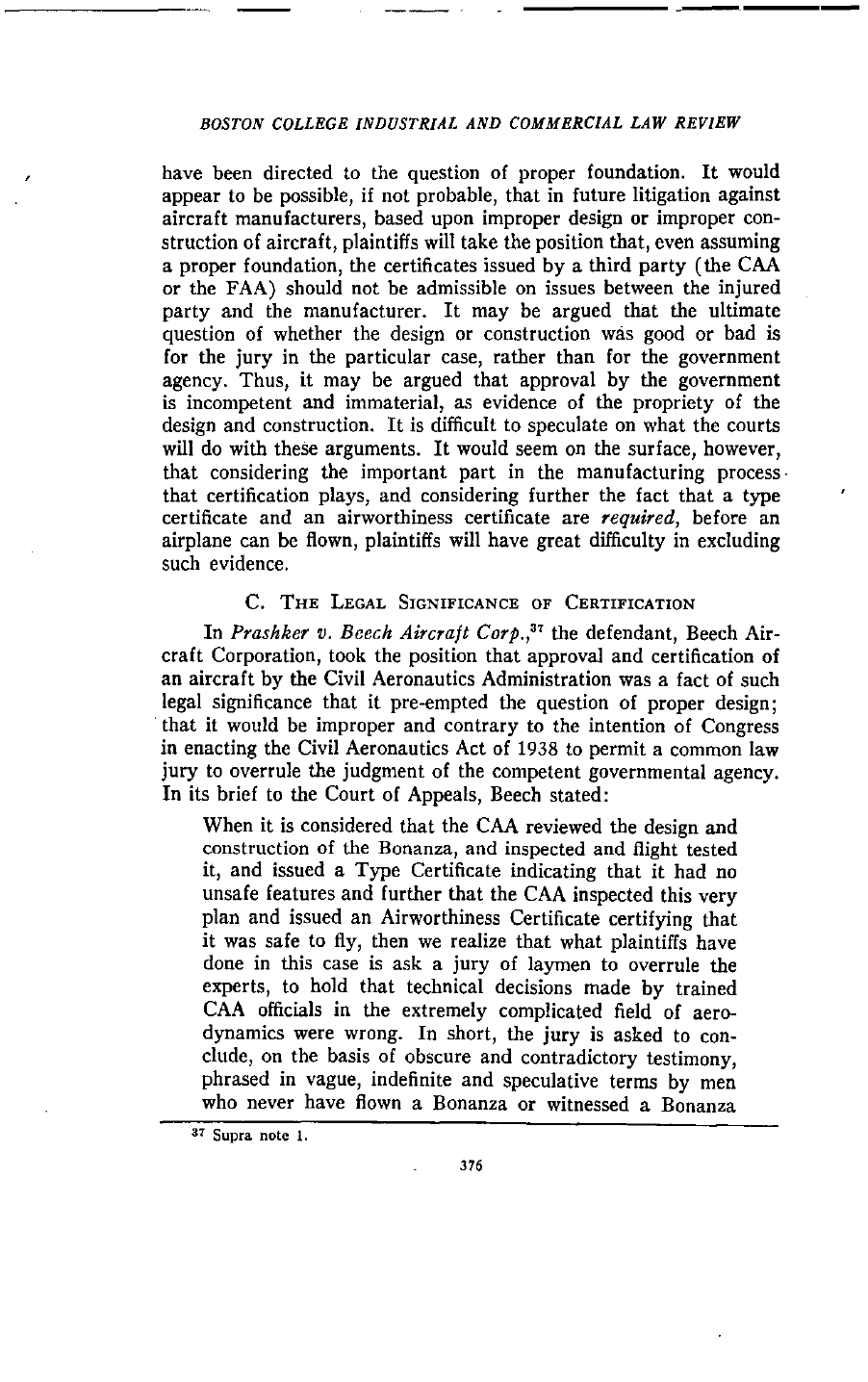
BOSTON COLLEGE INDUSTRIAL AND COMMERCIAL LAW REVIEW
have been directed to the question of proper foundation. It would
appear to
be
possible, if not probable, that in future litigation against
aircraft manufacturers, based upon improper design or improper con-
struction of aircraft, plaintiffs will take the position that, even assuming
a proper foundation, the certificates issued by a third party (the CAA
or the FAA) should not be admissible on issues between the injured
party and the manufacturer. It may be argued that the ultimate
question of whether the design or construction was good or bad is
for the jury in the particular case, rather than for the government
agency. Thus, it may be argued that approval by the government
is incompetent and immaterial, as evidence of the propriety of the
design and construction. It is difficult to speculate on what the courts
will do with these arguments. It would seem on the surface, however,
that considering the important part in the manufacturing process
that certification plays, and considering further the fact that a type
certificate and an airworthiness certificate are required,
before an
airplane can be flown, plaintiffs will have great difficulty in excluding
such evidence.
C. THE LEGAL SIGNIFICANCE OF CERTIFICATION
In
Prashker v. Beech Aircraft Carp.,"
the defendant, Beech Air-
craft Corporation, took the position that approval and certification of
an aircraft by the Civil Aeronautics Administration was a fact of such
legal significance that it pre-empted the question of proper design;
that it would be improper and contrary to the intention of Congress
in enacting the Civil Aeronautics Act of 1938 to permit a common law
jury to overrule the judgment of the competent governmental agency.
In its brief to the Court of Appeals, Beech stated:
When it is considered that the CAA reviewed the design and
construction of the Bonanza, and inspected and flight tested
it, and issued a Type Certificate indicating that it had no
unsafe features and further that the CM inspected this very
plan and issued an Airworthiness Certificate certifying that
it was safe to fly, then we realize that what plaintiffs have
done in this case is ask a jury of laymen to overrule the
experts, to hold that technical decisions made by trained
CAA officials in the extremely complicated field of aero-
dynamics were wrong. In short, the jury is asked to con-
clude, on the basis of obscure and contradictory testimony,
phrased in vague, indefinite and speculative terms by men
who never have flown a Bonanza or witnessed a Bonanza
37
Supra note 1.
376
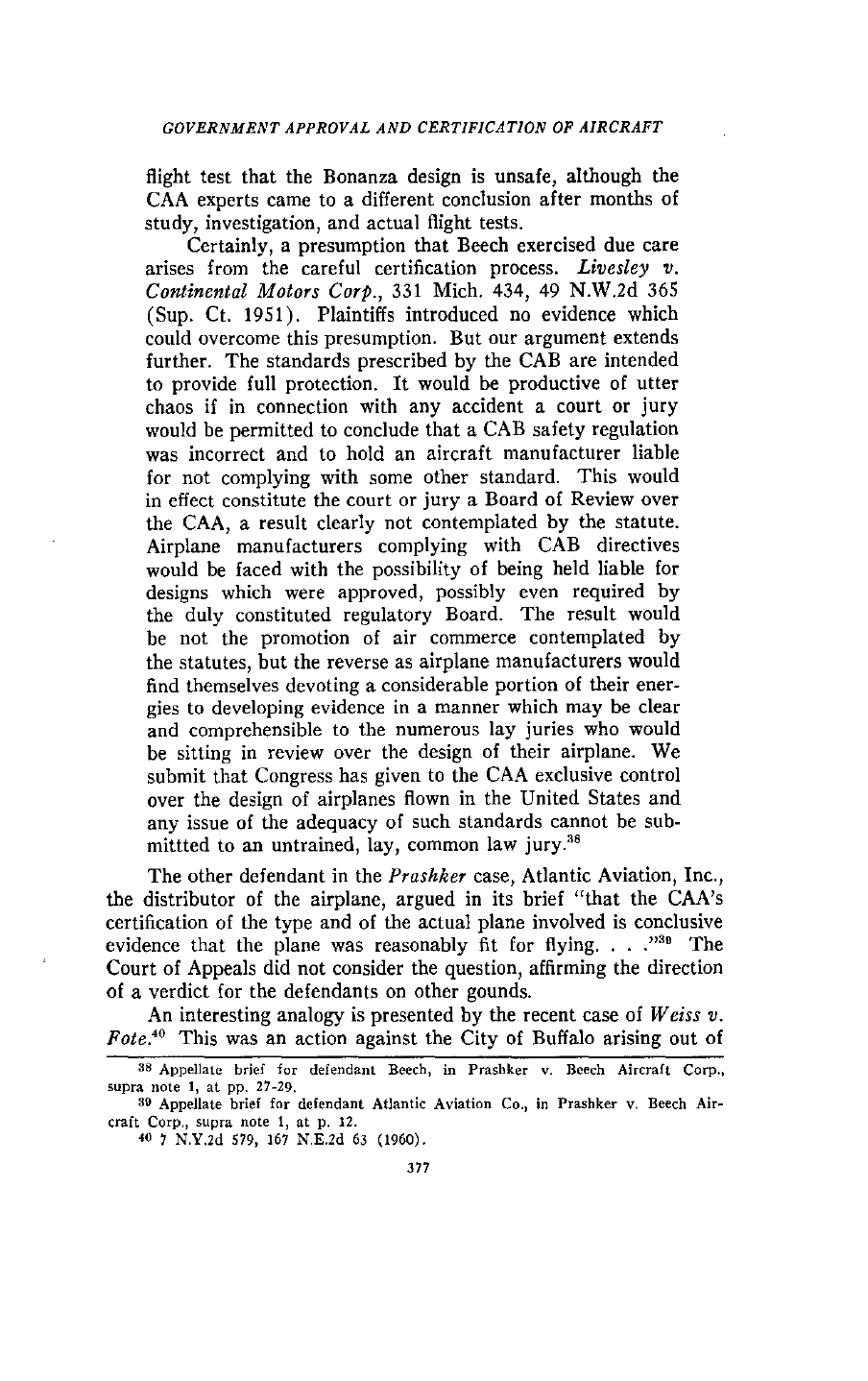
GOVERNMENT APPROVAL AND CERTIFICATION OF AIRCRAFT
flight test that the Bonanza design is unsafe, although the
CAA experts came to a different conclusion after months of
study, investigation, and actual flight tests.
Certainly, a presumption that Beech exercised due care
arises from the careful certification process.
Livesley v.
Continental Motors Corp.,
331 Mich. 434, 49 N.W.2d 365
(Sup. Ct. 1951). Plaintiffs introduced no evidence which
could overcome this presumption. But our argument extends
further. The standards prescribed by the CAB are intended
to provide full protection. It would be productive of utter
chaos if in connection with any accident a court or jury
would be permitted to conclude that a CAB safety regulation
was incorrect and to hold an aircraft manufacturer liable
for not complying with some other standard. This would
in effect constitute the court or jury a Board of Review over
the CAA, a result clearly not contemplated by the statute.
Airplane manufacturers complying with CAB directives
would be faced with the possibility of being held liable for
designs which were approved, possibly even required by
the duly constituted regulatory Board. The result would
be not the promotion of air commerce contemplated by
the statutes, but the reverse as airplane manufacturers would
find themselves devoting a considerable portion of their ener-
gies to developing evidence in a manner which may be clear
and comprehensible to the numerous lay juries who would
be sitting in review over the design of their airplane. We
submit that Congress has given to the CAA exclusive control
over the design of airplanes flown in the United States and
any issue of the adequacy of such standards cannot be sub-
mittted to an untrained, lay, common law jury.
38
The other defendant in the
Prashker
case, Atlantic Aviation, Inc.,
the distributor of the airplane, argued in its brief "that the CAA's
certification of the type and of the actual plane involved is conclusive
evidence that the plane was reasonably fit for flying. .. 2'
3
° The
Court of Appeals did not consider the question, affirming the direction
of a verdict for the defendants on other gounds.
An interesting analogy is presented by the recent case of
Weiss v.
Fote.
4
°
This was an action against the City of Buffalo arising out of
38
Appellate brief for defendant Beech, in Prashker v. Beech Aircraft Corp.,
supra note 1, at pp. 27-29,
39
Appellate brief for defendant Atlantic Aviation Co., in Prashker v. Beech Air-
craft Corp., supra note 1, at p. 12.
40
7 N.Y.2d 579, 167 N.E.2d 63 (1960).
377
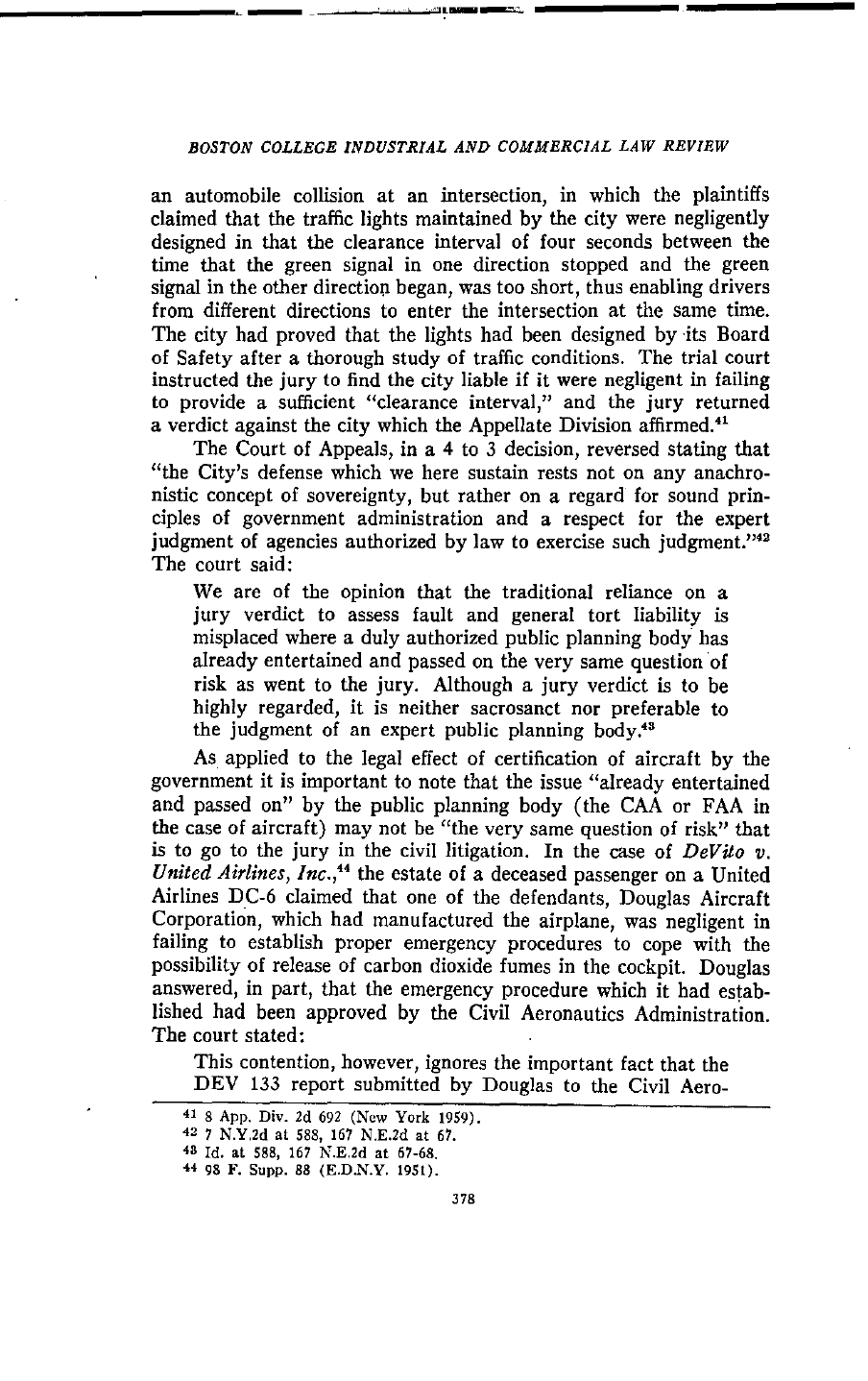
IIIMaU
BOSTON COLLEGE INDUSTRIAL AND COMMERCIAL LAW REVIEW
an automobile collision at an intersection, in which the plaintiffs
claimed that the traffic lights maintained by the city were negligently
designed in that the clearance interval of four seconds between the
time that the green signal in one direction stopped and the green
signal in the other direction began, was too short, thus enabling drivers
from different directions to enter the intersection at the same time.
The city had proved that the lights had been designed by its Board
of Safety after a thorough study of traffic conditions. The trial court
instructed the jury to find the city liable if it were negligent in failing
to provide a sufficient "clearance interval," and the jury returned
a verdict against the city which the Appellate Division affirmed.'
The Court of Appeals, in a 4 to
3
decision, reversed stating that
"the City's defense which we here sustain rests not on any anachro-
nistic concept of sovereignty, but rather on a regard for sound prin-
ciples of government administration and a respect for the expert
judgment of agencies authorized by law to exercise such judgment!'"
The court said:
We are of the opinion that the traditional reliance on a
jury verdict to assess fault and general tort liability is
misplaced where a duly authorized public planning body has
already entertained and passed on the very same question of
risk as went to the jury. Although a jury verdict is to be
highly regarded, it is neither sacrosanct nor preferable to
the judgment of an expert public planning body."
As applied to the legal effect of certification of aircraft by the
government it is important to note that the issue "already entertained
and passed on" by the public planning body (the CAA or FAA in
the case of aircraft) may not be "the very same question of risk" that
is to go to the jury in the civil litigation. In the case of
DeVito v.
United Airlines, Inc.,"
the estate of a deceased passenger on a United
Airlines DC-6 claimed that one of the defendants, Douglas Aircraft
Corporation, which had manufactured the airplane, was negligent in
failing to establish proper emergency procedures to cope with the
possibility of release of carbon dioxide fumes in the cockpit. Douglas
answered, in part, that the emergency procedure which it had estab-
lished had been approved by the Civil Aeronautics Administration.
The court stated:
This contention, however, ignores the important fact that the
DEV 133 report submitted by Douglas to the Civil Aero-
41
8 App. Div. 2d 692 (New York 1959).
42
7 N.Y.2d at 588, 167 N.E.2d at 67.
43
Id. at 588, 167 N.E.2d at 67-68.
44
98 F. Supp. 88 (E.D.N.Y. 1951).
378
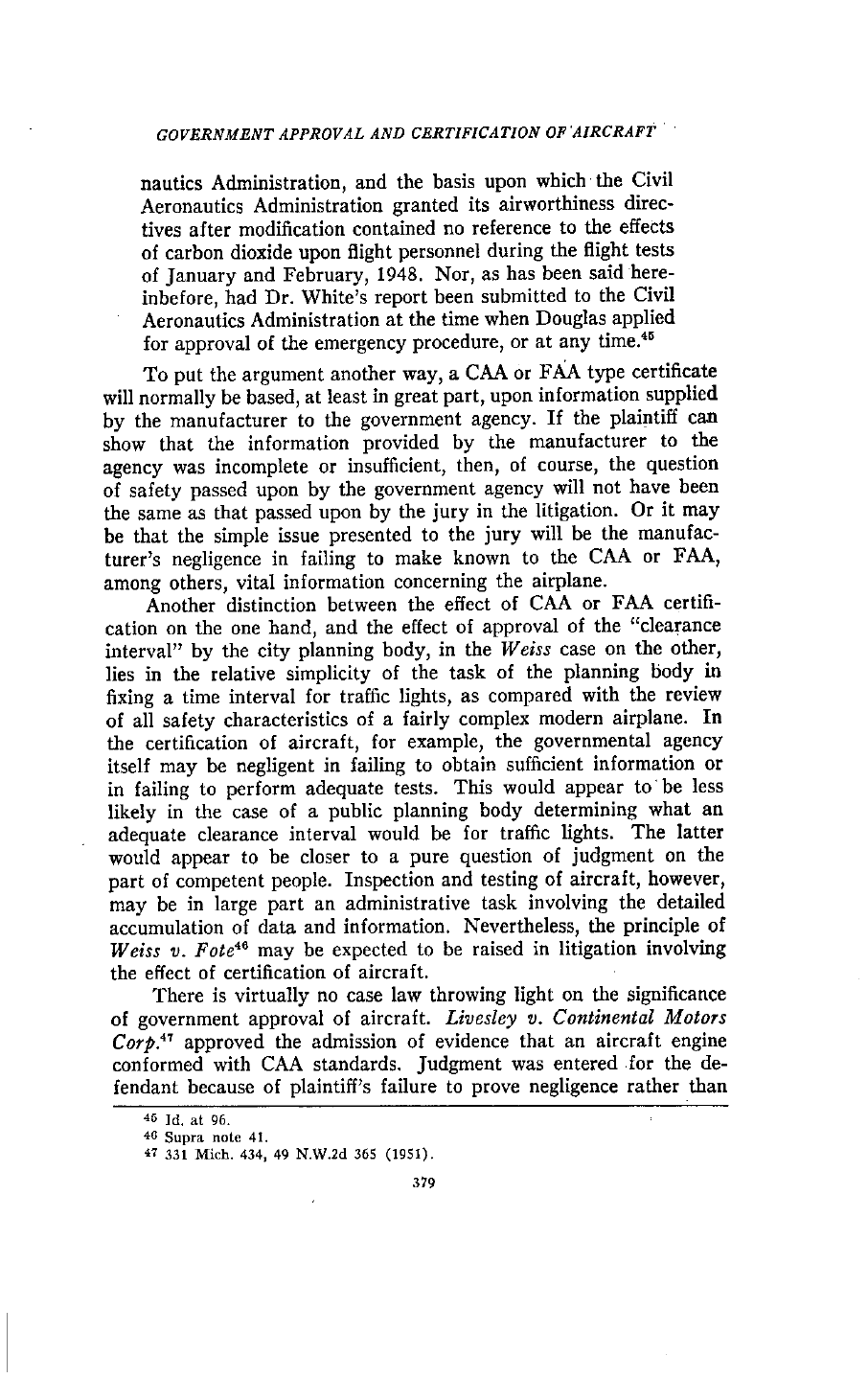
GOVERNMENT APPROVAL AND CERTIFICATION OF'AIRCRAFT
nautics Administration, and the basis upon which the Civil
Aeronautics Administration granted its airworthiness direc-
tives after modification contained no reference to the effects
of carbon dioxide upon flight personnel during the flight tests
of January and February, 1948. Nor, as has been said here-
inbefore, had Dr. White's report been submitted to the Civil
Aeronautics Administration at the time when Douglas applied
for approval of the emergency procedure, or at any time."
To put the argument another way, a CAA or FAA type certificate
will normally be based, at least in great part, upon information supplied
by the manufacturer to the government agency. If the plaintiff can
show that the information provided by the manufacturer to the
agency was incomplete or insufficient, then, of course, the question
of safety passed upon by the government agency will not have been
the same as that passed upon by the jury in the litigation. Or it may
be that the simple issue presented to the jury will be the manufac-
turer's negligence in failing to make known to the CAA or FAA,
among others, vital information concerning the airplane.
Another distinction between the effect of CAA or FAA certifi-
cation on the one hand, and the effect of approval of the "clearance
interval" by the city planning body, in the
Weiss
case on the other,
lies in the relative simplicity of the task of the planning body in
fixing a time interval for traffic lights, as compared with the review
of all safety characteristics of a fairly complex modern airplane. In
the certification of aircraft, for example, the governmental agency
itself may be negligent in failing to obtain sufficient information or
in failing to perform adequate tests. This would appear to be less
likely in the case of a public planning body determining what an
adequate clearance interval would be for traffic lights. The latter
would appear to be closer to a pure question of judgment on the
part of competent people. Inspection and testing of aircraft, however,
may be in large part an administrative task involving the detailed
accumulation of data and information. Nevertheless, the principle of
Weiss v. Foie"
may be expected to be raised in litigation involving
the effect of certification of aircraft.
There is virtually no case law throwing light on the significance
of government approval of aircraft.
Livesley v. Continental Motors
Corp:"
approved the admission of evidence that an aircraft engine
conformed with CAA standards. Judgment was entered for the de-
fendant because of plaintiff's failure to prove negligence rather than
45
Id. at 96.
46
Supra note 41.
47
331 Mich. 434, 49 N.W.2d 365 (1951).
379
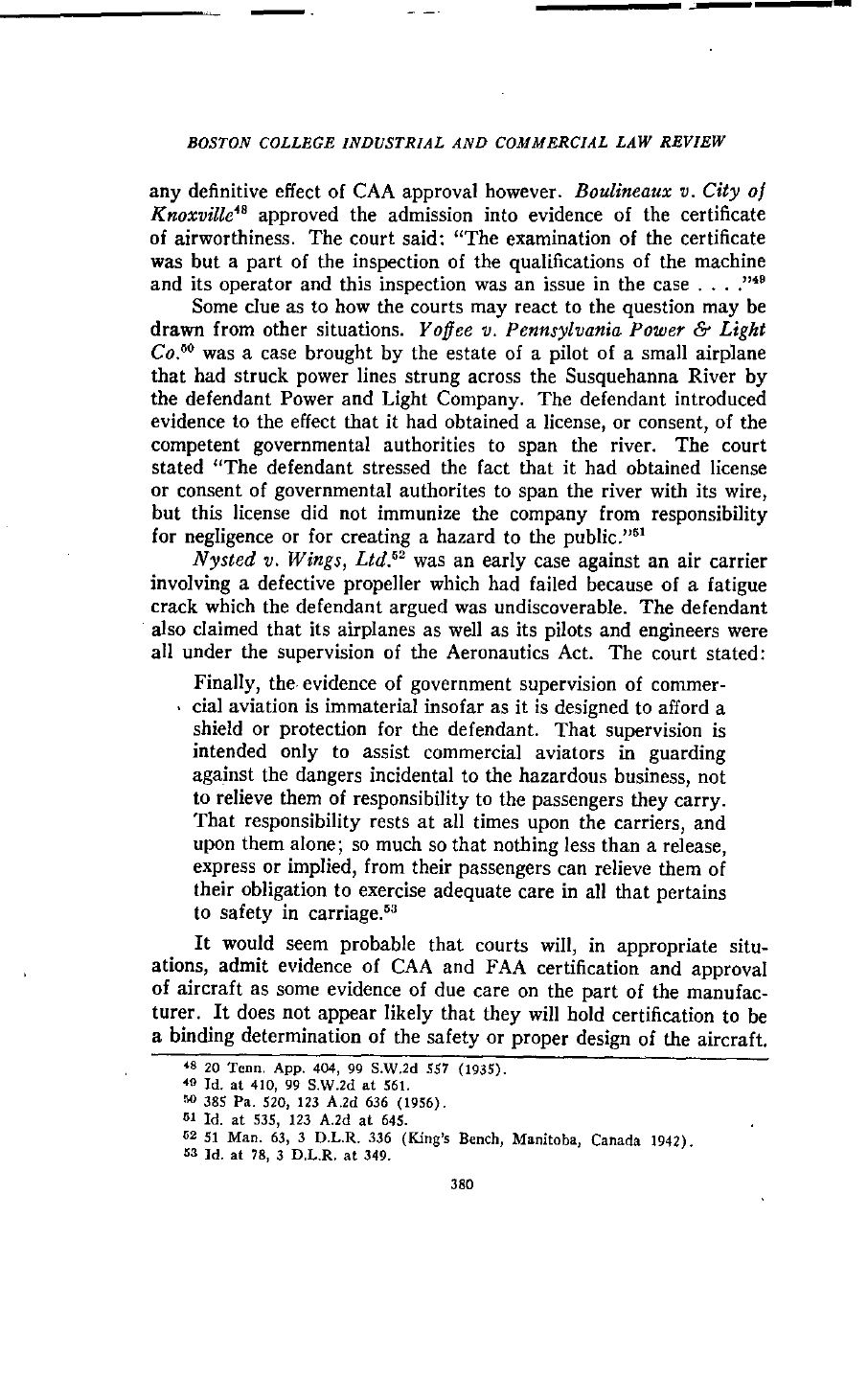
BOSTON COLLEGE INDUSTRIAL AND COMMERCIAL LAW REVIEW
any definitive effect of CAA approval however.
Boulineaux v. City of
Knoxville'
s
approved the admission into evidence of the certificate
of airworthiness. The court said: "The examination of the certificate
was but a part of the inspection of the qualifications of the machine
and its operator and this inspection was an issue in the case . .""
Some clue as to how the courts may react to the question may be
drawn from other situations.
Yoffee v. Pennsylvania Power & Light
Co.°
was a case brought by the estate of a pilot of a small airplane
that had struck power lines strung across the Susquehanna River by
the defendant Power and Light Company. The defendant introduced
evidence to the effect that it had obtained a license, or consent, of the
competent governmental authorities to span the river. The court
stated "The defendant stressed the fact that it had obtained license
or consent of governmental authorites to span the river with its wire,
but this license did not immunize the company from responsibility
for negligence or for creating a hazard to the public!"
61
Nysted v. Wings, Ltd.s
s
was an early case against an air carrier
involving a defective propeller which had failed because of a fatigue
crack which the defendant argued was undiscoverable. The defendant
also claimed that its airplanes as well as its pilots and engineers were
all under the supervision of the Aeronautics Act. The court stated:
Finally, the evidence of government supervision of commer-
cial aviation is immaterial insofar as it is designed to afford a
shield or protection for the defendant. That supervision is
intended only to assist commercial aviators in guarding
against the dangers incidental to the hazardous business, not
to relieve them of responsibility to the passengers they carry.
That responsibility rests at all times upon the carriers, and
upon them alone; so much so that nothing less than a release,
express or implied, from their passengers can relieve them of
their obligation to exercise adequate care in all that pertains
to safety in carriage."
It would seem probable that courts will, in appropriate situ-
ations, admit evidence of CAA and FAA certification and approval
of aircraft as some evidence of due care on the part of the manufac-
turer. It does not appear likely that they will hold certification to be
a binding determination of the safety or proper design of the aircraft.
48
20 Tenn. App. 404, 99 S.W.2d 557 (1935).
49
Id. at 410, 99 S.W.2d at 561.
5
°
385 Pa. 520, 123 A.2d 636 (1956).
51
Id. at 535, 123 A.2d at 645.
52 51 Man. 63, 3 D.L.R. 336 (King's Bench, Manitoba, Canada 1942).
53
Id. at 78, 3 D.L.R. at 349.
380
